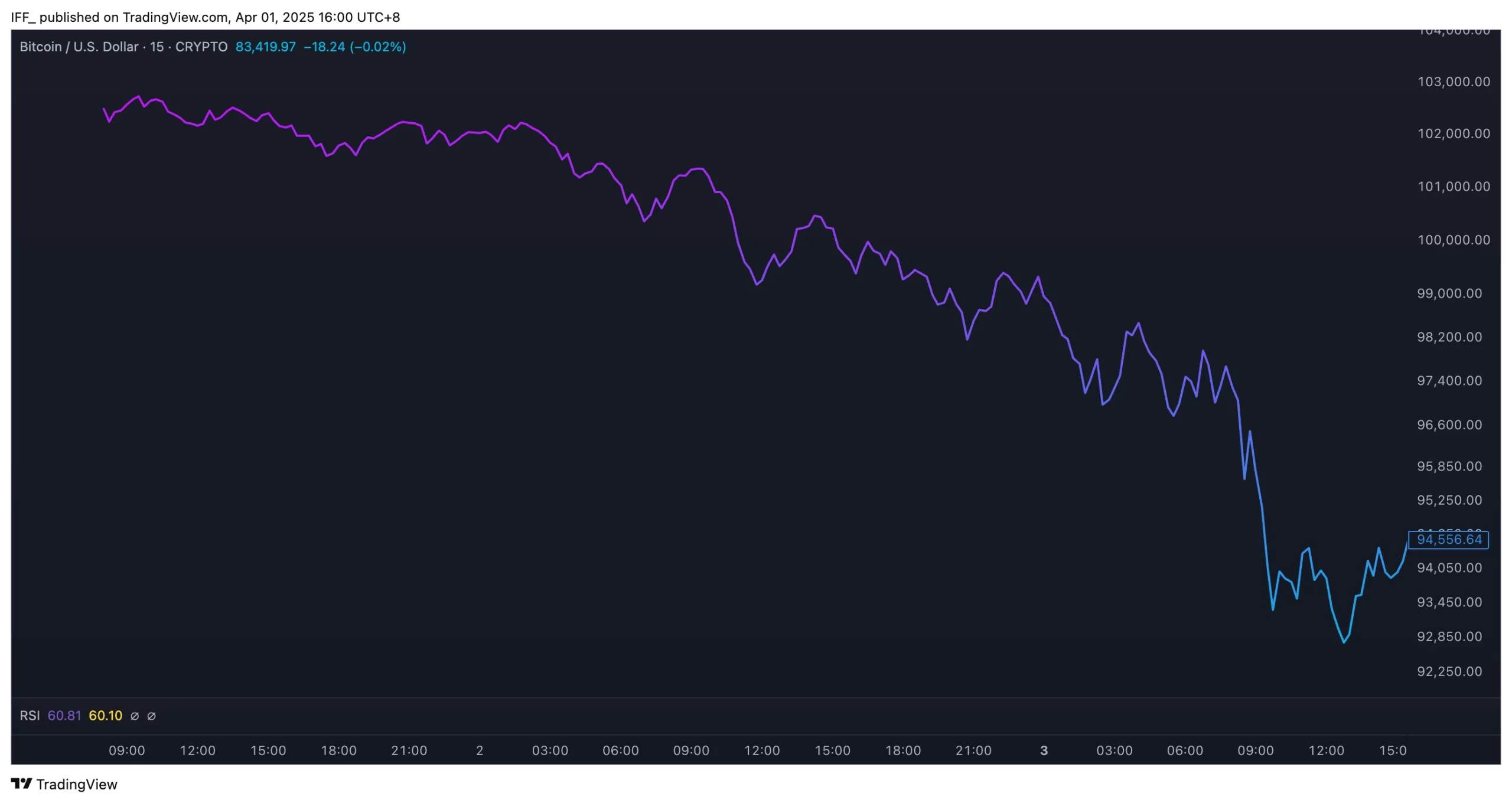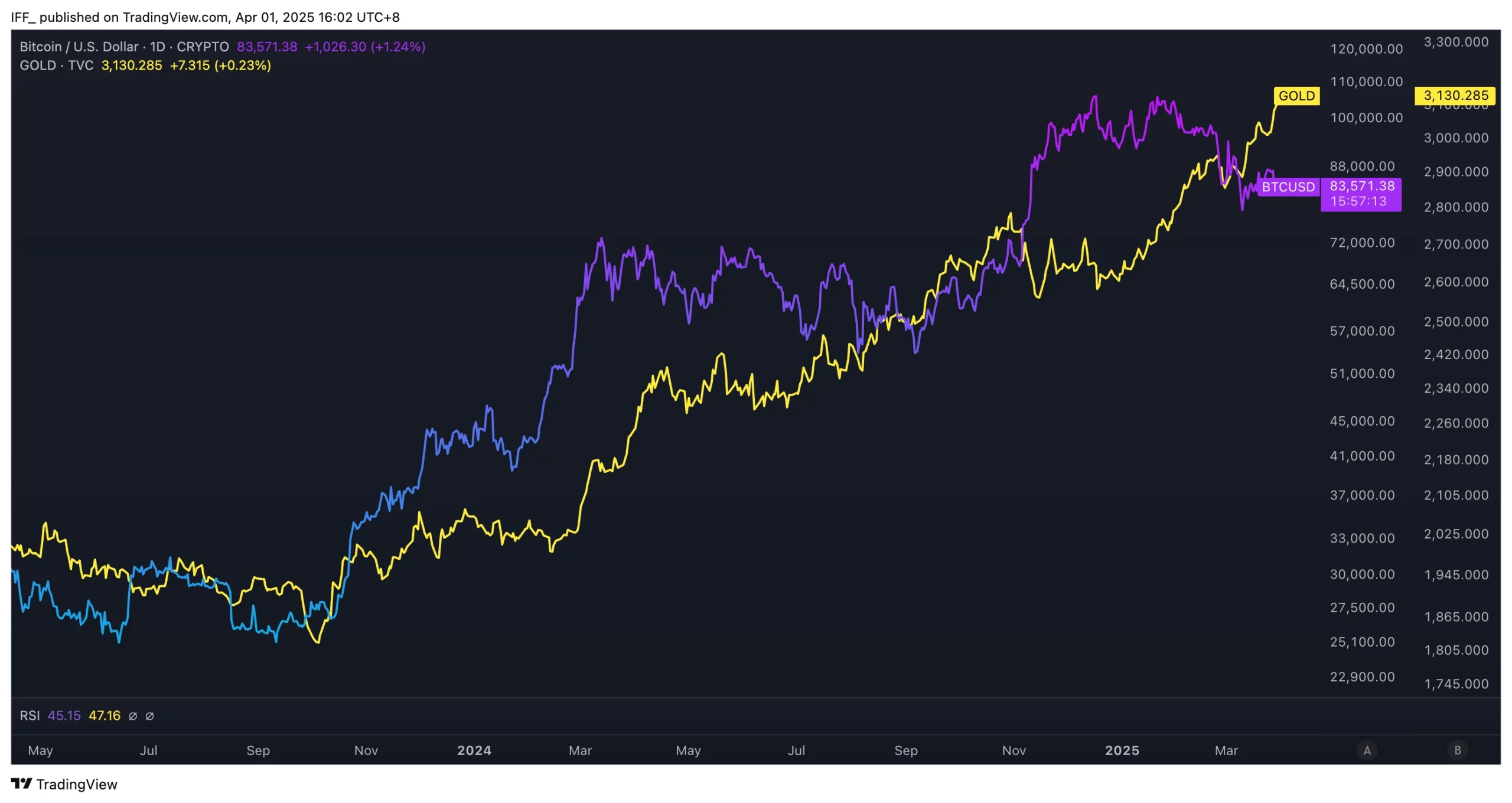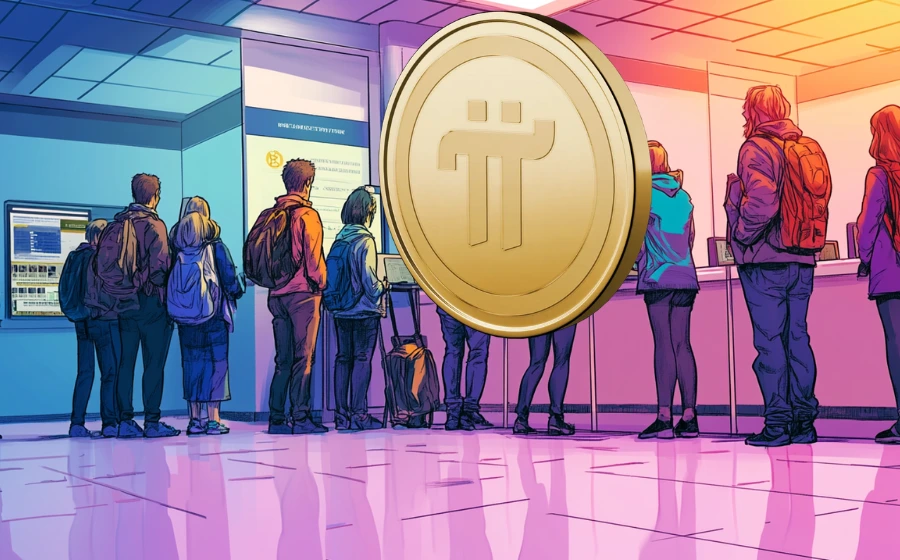
KEYTAKEAWAYS
- U.S. tariff policies may cause short-term crypto volatility, with Bitcoin possibly testing $80,000 and altcoins seeing sharper declines.
- Long-term inflation risk could boost Bitcoin’s “digital gold” appeal, while mining costs and dollar strength reshape the market.
- Institutional investors may reduce exposure during uncertainty, but could return if policy impact proves mild or inflation drives demand.

CONTENT
As of April 1, 2025, the market is closely watching the upcoming U.S. tariff policy announcement scheduled for April 3. This analysis suggests the new policy could bring short-term volatility to the crypto market. Bitcoin may test the key support level around $80,000, while altcoins could face even bigger drops. In the long run, if the policy leads to ongoing inflation, Bitcoin’s role as “digital gold” might gain more attention.
At the same time, the strength of the U.S. dollar and rising mining costs may reshape the market. Investors should stay cautious, adjust strategies flexibly, and watch how the market reacts after the policy is released.
INTRODUCTION
As of April 1, 2025, markets are both hopeful and nervous about the U.S. tariff policy set to be revealed on April 3. As a global economic force, the U.S. can shake not only traditional markets but also the very sensitive crypto ecosystem with its trade actions. This article looks at both short-term and long-term impacts of the new tariffs on crypto, using current trends, past patterns, and online discussions to help investors prepare.
1. SHORT-TERM EFFECTS: VOLATILITY AND RISK-OFF SENTIMENT
The upcoming U.S. tariff policy could act as a trigger for strong short-term price moves in the crypto market. Here are three main drivers of the short-term impact:
1.1 More Uncertainty = More Fear
Tariff policies are often seen as protectionist and can lead to higher import costs, a stronger U.S. dollar, and rising global trade tensions. When uncertainty rises, investors usually shift money from risky assets (like crypto) into safer ones like cash, gold, or government bonds. Bitcoin and Ethereum, seen as high-risk assets, could face selling pressure.
Example: In February 2025, when the Trump administration raised tariffs on Canada, Mexico, and China, Bitcoin dropped sharply within a week. If the April 3 policy continues this trend with more or higher tariffs, Bitcoin may quickly test the $80,000 support level. Altcoins like ETH or SOL could drop 10%-20%.

1.2 Emotional Reactions to Big News
Crypto markets are more sensitive to big economic news than traditional markets. If tariffs raise inflation fears, the U.S. Federal Reserve might keep interest rates high or raise them further—bad news for assets like Bitcoin that don’t pay interest.
Typically, investors “sell first, buy later” when facing policy uncertainty. If the April 3 announcement is stronger than expected (like across-the-board tariff hikes), fear-driven selling could worsen, pushing prices even lower.
1.3 Liquidity Problems Could Spread
If U.S. stocks fall after the policy news, investors may sell crypto holdings to raise cash. In February 2025, the total crypto market cap dropped sharply after U.S. stocks fell, showing how traditional and crypto markets are linked.
If this pattern repeats, Bitcoin might fall to the lower end of its current range ($80K–$85K), and altcoins could lose 20%-30%, especially tokens with heavy leverage.
Short-Term Outlook:
If the tariff plan is mild, the market may bounce back quickly after an initial panic. But if the policy is tougher than expected, technical stop-loss selling could trigger a deeper drop.
2. LONG-TERM IMPACT: RISKS AND OPPORTUNITIES
Over time, the effect of tariffs will depend on how they change inflation, capital flows, and market structure. Here are four long-term trends to watch:
2.1 Inflation Hedge: Bitcoin as “Digital Gold”
If tariffs disrupt supply chains and raise prices, inflation could rise. Bitcoin may gain favor as a hedge. While it may fall at first due to slower growth, its fixed supply and decentralized nature could make it attractive during economic uncertainty.
History Note: In the 2018–2020 U.S.-China trade war, Bitcoin fell early but surged later during the COVID crisis and inflation fears, hitting $20,000.
If inflation in the U.S. rises (for example, CPI above 4.5%), Bitcoin might regain its “digital gold” image. However, more government regulation due to economic stress could limit long-term growth.

2.2 Strong vs Weak Dollar: Where Will the Money Go?
If tariffs make the U.S. dollar stronger (due to less imports or more trade balance), crypto prices may fall in the short term. But if the trade war weakens the economy (GDP growth below 2%), the dollar could weaken, pushing investors toward crypto.
Example: In February 2025, the U.S. dollar index (DXY) spiked to 110 but dropped back to 105. Bitcoin rebounded soon after, showing a clear inverse relationship.
Over time, Bitcoin’s direction may depend heavily on the dollar. A weak dollar could help Bitcoin rise above $85,000. A strong dollar could keep it stuck below $80,000.
2.3 Mining Costs: Hardware, Tariffs, and Hash Rate
Tariffs on Chinese goods could raise the cost of mining equipment like ASICs (used for Bitcoin mining). Chinese makers produce over 70% of the world’s ASICs. A 25% tariff could increase prices from $2,000 to $2,500 per unit and reduce annual profits by 10%-15%.
Impact:
•Higher costs may push U.S. miners to find new suppliers or make equipment locally.
•This could lead to a more global distribution of mining power (hash rate).
•In the short term, sudden changes in hash power may raise security concerns, possibly hurting Bitcoin prices.
3. MARKET CONDITIONS AND FORECAST
As of April 1, 2025, Bitcoin is trading between $80K and $85K. Some of the tariff policy expectations may already be priced in. Altcoins are showing mixed performance.
Key Crypto Technicals
•Bitcoin (BTC): Trading around $82,000, with support at $80K and $78K. RSI near 55 = neutral to slightly strong. Lower trading volume shows many investors are waiting.
•Ethereum (ETH): ETH/BTC ratio is at a historical low (0.022). If markets turn risk-averse, it could fall further. But for long-term investors, this may be a good buying level.
•DeFi: Total value locked (TVL) is down 12% since January, showing risk appetite is low. This sector may signal early shifts in investor sentiment after the policy is revealed.
Three Scenarios
1. Positive:
If tariffs are small and targeted, panic may fade quickly. Bitcoin could climb back above $85K within a week, and altcoins might rise 10%-15%.
2. Neutral:
If tariffs match expectations (5%-15%), Bitcoin may stay between $80K–$85K for 2–3 weeks while markets wait for more data.
3. Negative:
If tariffs are broad and trigger retaliation, Bitcoin might fall below $80K. Altcoins could drop 20%-30%. DeFi and stablecoins may show better resilience.
4. INSTITUTIONAL INVESTOR BEHAVIOR
Institutions react differently to market shocks. Here’s what to watch:
4.1 ETF Flows
Bitcoin spot ETFs launched in early 2024 and attracted over $30 billion. Around big policy events, ETFs often show outflows for 1-2 weeks before recovering. Watch IBIT, GBTC, and others for daily flows.
4.2 Futures and Options
CME Bitcoin futures currently show low premiums over spot prices—signs of caution. If premiums jump to over 3% after April 3, it may mean traders are feeling more confident again.
4.3 Institutional Holdings
Institutional Bitcoin holdings fell from 8.5% in late 2024 to 7.8% in Q1 2025. If tariffs are soft, they may buy again in Q2. If not, risk-off moves could last longer.
FINAL THOUGHTS & INVESTMENT TIPS
The U.S. tariff policy could trigger sharp short-term drops in crypto, especially altcoins. Long-term effects depend on inflation, dollar strength, and mining shifts.
Advice:
•Know your risk tolerance.
•Don’t invest more than you can afford to lose.
•Keep enough cash during uncertain times.
•Stay alert after the policy is announced.
▶ Buy Crypto at Bitget
CoinRank x Bitget – Sign up & Trade to get $20!
















